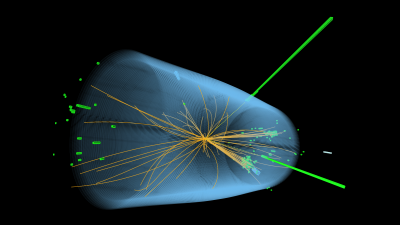
A candidate event for the production of a Higgs boson and its disintegration in two photons, in the CMS detector at the CERN Large Hadron Collider (LHC).
The great questions in particle physics and cosmology
The physicists at the Particle Physics Division are tackling some of the deepest questions in modern particle physics and cosmology.
What are the fundamental symmetries ruling the subatomic world?
Are the properties of the Higgs boson, discovered at the CERN LHC in 2012, consistent with the predictions of the Standard Model of Particle Physics? Will the detailed study of the Higgs boson be the key of the physics beyond the Standard Model, and will it unveil the nature of dark matter?
Why is the gravitational force so incredibly weak compared to electromagnetism and the nuclear forces? Are there additional dimensions of space?
Are gravitational and inertial mass equivalent? What is the behaviour of antimatter in the Earth gravitational field?
Is the neutrino a Makorana particle, i.e., a fermion that is its own antiparticle? Is the CP symmetry between matter and antimatter broken in the flavour oscillations that neutrinos undergo in their propagation? Is the very small but non-zero mass of neutrinos telling us something about the cosmic asymmetry between matter and antimatter?
Which large colliders for the future? What is the best strategy at the French, European and global level to make progress in the understanding of the physical world?
What is the nature of dark matter? Can dark matter in the surrounding space be detected thanks to very-low-noise underground detectors? Can signals of dark matter be observed in very-high-energy gamma rays originating from the center of the Galaxy? Can the production of dark matter particles be observed in very-high-energy proton-proton collisions at the LHC?
What is the nature of dark energy? Is this a cosmological constant or has it been evolving in the past history of the Universe? Can we combine all the cosmological probes (cosmic microwave background, supernovae, baryon acoustic oscillations, redshift spectral distorsions, weak shear, etc.) to disentangle the various components of the cosmic expansion?
Can one develop new principles of detection with improved sensitivity, speed, and radiation hardness, at a reasonable cost?
Can one exploit the technology developed in particle physics for societal purposes, as for instance medical imaging or alternate source of electric power?
